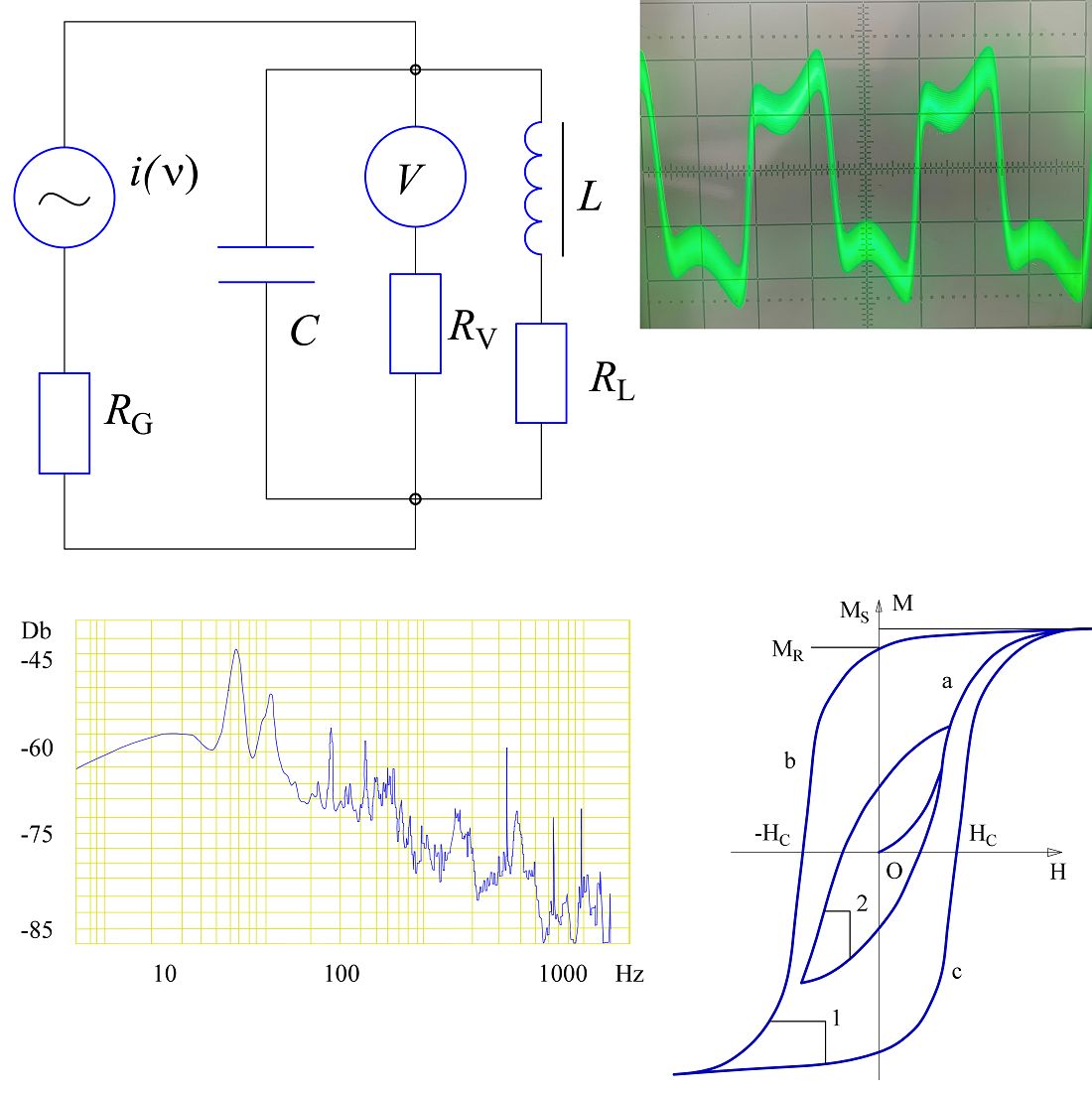Establishing mechanisms for nonlinear collector tribodynamics of magnetization under ferroresonance regimes
DOI:
https://doi.org/10.15587/1729-4061.2024.304327Keywords:
ferroresonance, oscillating circuit, magnetization dynamics, collector system, magnetic moment, contact tribodynamicsAbstract
The paper considers a parallel electromagnetic oscillating circuit with a nonlinear inductance under conditions of excitation of ferroresonances. Physical mechanisms of dynamic self-regulation of the system of spin magnetic moments of ferromagnetic and ferrimagnetic dielectrics in the surrounding magnetic field are established. It is shown that upon entering the magnetic saturation regime, the effect of dynamic antiferroresonance is observed, due to the cyclic reversal of magnetization in the internal magnetic field. This effect has a collector character and corresponds to the maximum potential energy of the magnetic moment in the field and the antiparallel orientation of the moment with respect to the field. Such regimes are realized in thermodynamically non-equilibrium conditions and are correlated with unstable equilibrium positions of the corresponding mechanical analogues. The resulting forms of oscillations correlate with the dynamics of an inverted pendulum and have a significantly non-harmonic character. Autosynchronization of frequencies and nonlinear mixing of such forms with quasi-static modes imitating the time form of external excitation of oscillations were revealed. It is shown that the nonlinearity of ferromagnetic elements self-limits the height of resonance maxima. And on the other hand, it contributes to the cascade transport of energy by the spectrum of disturbances, which can have negative consequences when exciting low-frequency ferroresonances in power grids. The effect of dynamic antiferroresonance has the opposite direction to the known quasi-static behavior of the system of spin magnetic moments in an external field and must be taken into account when calculating and operating electrical systems with nonlinear inductances. Examples of collector self-oscillating modes similar in their physical mechanisms in nonlinear contact tribodynamics systems are given
References
- Bakhor, Z., Yatseiko, A., Ferensovych, R. (2020). Assessment of ferroresonance processes in schemes of 6-35 kV electrical grids on the basis of reliability analysis. Energy Engineering and Control Systems, 6 (2), 137–145. https://doi.org/10.23939/jeecs2020.02.137
- Akinci, T. C., Akgun, O., Yilmaz, M., Martinez-Morales, A. A. (2023). High Order Spectral Analysis of Ferroresonance Phenomena in Electric Power Systems. IEEE Access, 11, 61289–61297. https://doi.org/10.1109/access.2023.3286817
- Olguín-Becerril, M. A., Angeles-Camacho, C., Fuerte-Esquivel, C. R. (2014). Ferroresonance in subharmonic 3rd mode in an inductive voltage transformer, a real case analysis. International Journal of Electrical Power & Energy Systems, 61, 318–325. https://doi.org/10.1016/j.ijepes.2014.03.057
- Sharbain, H. A., Osman, A., El-Hag, A. (2017). Detection and identification of ferroresonance. 2017 7th International Conference on Modeling, Simulation, and Applied Optimization (ICMSAO). https://doi.org/10.1109/icmsao.2017.7934904
- Martinez, R., Arroyo, A., Pigazo, A., Manana, M., Bayona, E., Azcondo, F. J. et al. (2022). Acoustic Noise-Based Detection of Ferroresonance Events in Isolated Neutral Power Systems with Inductive Voltage Transformers. Sensors, 23(1), 195. https://doi.org/10.3390/s23010195
- Klimas, M., Majka, Ł. (2019). Enhancing the possibilities in visualisation of the ferroresonance phenomenon. Poznan University of Technology Academic Journals. Electrical Engineering, 98, 115–124. https://doi.org/10.21008/j.1897-0737.2019.98.0010
- Solak, K., Rebizant, W., Kereit, M. (2020). Detection of Ferroresonance Oscillations in Medium Voltage Networks. Energies, 13 (16), 4129. https://doi.org/10.3390/en13164129
- Schmool, D. S., Markó, D., Lin, K.-W., Hierro-Rodríguez, A., Quirós, C., Díaz, J. et al. (2021). Ferromagnetic Resonance Studies in Magnetic Nanosystems. Magnetochemistry, 7 (9), 126. https://doi.org/10.3390/magnetochemistry7090126
- Abdel-hamed, A. M., M. EL-Shafhy, M., A. Badran, E. (2022). Elimination of ferroresonance in the distribution zone by high ohmic reactor-shunt limiter. Indonesian Journal of Electrical Engineering and Computer Science, 28 (3), 1286. https://doi.org/10.11591/ijeecs.v28.i3.pp1286-1296
- Zaspa, Y., Dykha, A., Marchenko, D., Matiukh, S., Kukurudzyak, Y. (2020). Exchange interaction and models of contact generation of disturbances in tribosystems. Eastern-European Journal of Enterprise Technologies, 4 (5 (106)), 25–34. https://doi.org/10.15587/1729-4061.2020.209927
- Dykha, A. V., Zaspa, Yu. P., Slashchuk, V. O. (2018). Triboacoustic Control of Fretting. Journal of Friction and Wear, 39 (2), 169–172. https://doi.org/10.3103/s1068366618020046
- Dykha, A., Makovkin, O. (2019). Physical basis of contact mechanics of surfaces. Journal of Physics: Conference Series, 1172, 012003. https://doi.org/10.1088/1742-6596/1172/1/012003

Downloads
Published
How to Cite
Issue
Section
License
Copyright (c) 2024 Yuriy Zaspa, Aleksandr Dykha, Serhii Matiukh, Maksym Dykha, Oleksandr Lytvynov

This work is licensed under a Creative Commons Attribution 4.0 International License.
The consolidation and conditions for the transfer of copyright (identification of authorship) is carried out in the License Agreement. In particular, the authors reserve the right to the authorship of their manuscript and transfer the first publication of this work to the journal under the terms of the Creative Commons CC BY license. At the same time, they have the right to conclude on their own additional agreements concerning the non-exclusive distribution of the work in the form in which it was published by this journal, but provided that the link to the first publication of the article in this journal is preserved.
A license agreement is a document in which the author warrants that he/she owns all copyright for the work (manuscript, article, etc.).
The authors, signing the License Agreement with TECHNOLOGY CENTER PC, have all rights to the further use of their work, provided that they link to our edition in which the work was published.
According to the terms of the License Agreement, the Publisher TECHNOLOGY CENTER PC does not take away your copyrights and receives permission from the authors to use and dissemination of the publication through the world's scientific resources (own electronic resources, scientometric databases, repositories, libraries, etc.).
In the absence of a signed License Agreement or in the absence of this agreement of identifiers allowing to identify the identity of the author, the editors have no right to work with the manuscript.
It is important to remember that there is another type of agreement between authors and publishers – when copyright is transferred from the authors to the publisher. In this case, the authors lose ownership of their work and may not use it in any way.









